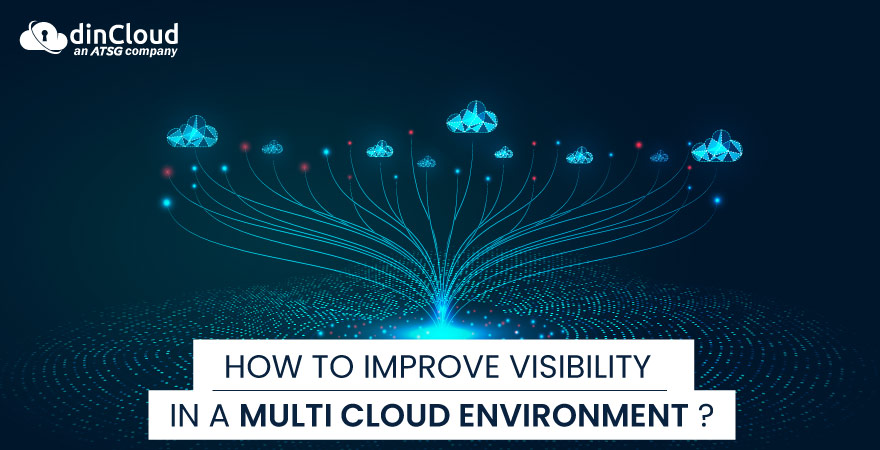The exponential growth of Cloud Computing has left a profound influence on businesses. The value proposition of cloud computing, alone, can help us explain the rapid expansion of Cloud based environments. With public cloud technologies gaining more agility and power, an increasing number of organizations are now opting for multi-cloud solutions.
According to a Connecticut based research and consultation firm, Gartner, 81% of the organizations, in 2022, are currently working with multiple Cloud Service Providers (CSP).

It is vital that we closely monitor all the actions taking place across the multi-cloud environments. With right machines crunching the right data, effective monitoring of multi-cloud infrastructures can help businesses achieve exponential growth.
Importance of Visibility in Cloud Computing
In cloud computing, visibility means that enterprises can have a detailed view of all the activities taking place within their cloud environment(s). With the help of specific tools, visibility helps identify security threats and inefficiencies in performances. This difficult, yet achievable task of assessing complex system behaviors, will consequently reduce enterprise security risks and increase the overall performance as well as efficiency.
Since multi-cloud environments involve an amalgamation of various Public Clouds, it is important to have a top-down or application-centric approach for a clear view of potential malicious behaviors, that can prove dangerous for an enterprise.
Related: Hybrid and Multi Cloud Environments – The Pros and Cons
A lack of visibility can sometimes create a glitch in smooth usage of dynamic storage and multiple computational services offered by various Public Cloud Providers. A unified platform, to easily monitor multi-cloud activities, can help organizations achieve better visibility.
How to Attain Visibility in a Multi-Cloud Environment
Growth in the cloud-based market has encouraged Cloud Service Providers, like dinCloud, to come up with customizable cloud-based solutions. Enterprises can use the following two methods to achieve better visibility in multi-cloud environments.
1. Unified View Approach
The first method adopts a single pane of glass approach. Here, each cloud service provider, deployed in a multi cloud environment, will use its own specific applications, with no one crossing each other’s boundary. The advantage of this unified view approach is that specific tools are not required to increase visibility.
2. Deployment of Applications and Components
The second approach sees multi-cloud as a collective platform, where protocols of application deployment are different and dependent on multiple factors. These factors are invisible to the independent cloud environments, but the state of resources impact them in each independent cloud.
Related: Why Will Multi Cloud be the Future of Cloud?
Advantages of Multi-cloud Visibility
For smooth running of applications and continuity in operations, visibility in multi-cloud is crucial. Excluding a top-down planning approach towards multi-cloud can prove detrimental to visibility. A keen overview across the landscape of a multi-cloud environment will be beneficial. Visibility in multi-cloud has many advantages. Some of them are listed below.
- Application uptime and Quality of Experience (QoE) is greatly enhanced with multi-cloud visibility. When error-rate is reduced, it consequently enhances employee efficiency. Collectively, all this creates value for an organization.
- Visibility can help forecast the state of cloud applications. This can further help businesses in capacity planning and performance management. An organization, well-versed with scaling rules, knows how differences in application usage can impact the quality of user’s experience.
- Attack surface of an application gets altered when there is a change in application configuration and workflow. It is extremely vital that organizations are aware of the exact time these changes are taking place. Visibility will help enterprises track these changes easily.
- Whenever there is an unusual behavior or pattern across the multi-cloud platform, it will be highlighted through visibility. This will help organizations in effectively managing vulnerabilities and protecting against exploitation.
Visibility Tools for the Multi-Cloud
An enterprise can use various tools to improve visibility across its multi-cloud environment. These visibility tools should focus on security, orchestration and infrastructure as code.
The most important thing for multi-cloud visibility is that enterprises should be able to classify the very nature of their multi-cloud infrastructures. Common source multi-cloud has applications, which can cross cloud boundaries through re-deployment or scaling. Parallel source multi-cloud, on the other hand, is unable to do this.
If all the cloud service providers m(CSP) are given a common source, such visibility structures should be used that support these cross-cloud operations. On the contrary, if each cloud is deployed separately, you need something that would centralize visibility of your cloud environment.
Related: The Outlook for Multi Cloud Deployments in the Year 2022
Conclusion
With numerous benefits of multi-cloud platforms coming to the surface, even the skeptics of cloud-based architectures are now appreciating its worth. To further expand their digital transformation, businesses opt for cloud service providers (CSP), that will help them reduce management complexities and offer smooth application modernizations. Having a higher negotiating power and lesser dependency on a single vendor, businesses can leverage multi-cloud solutions to extract maximum value for themselves.
Feel free to Contact dinCloud, an ATSG company, that specializes in providing customizable cloud services that are secure, flexible and agile.


